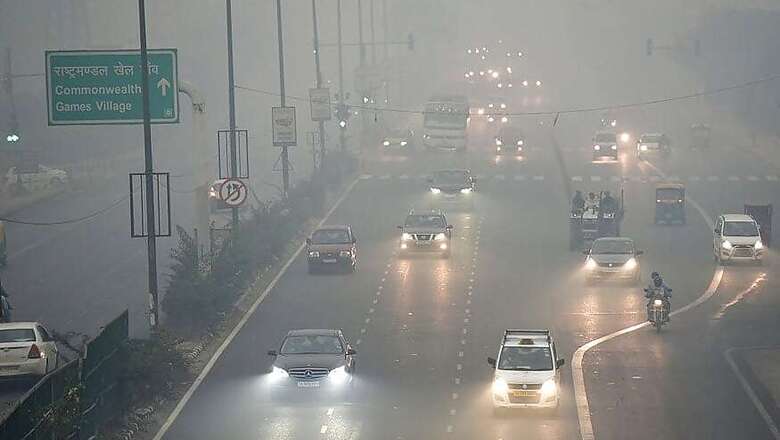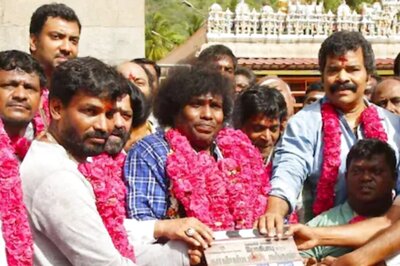
views
New Delhi: If the Delhi government has its way, November 13 would see the return of the odd-even car-rationing scheme in one desperate bid to bring down skyrocketing levels of air pollution in the city.
Aimed at lessening pollution from vehicular emissions by, theoretically, halving the number of cars on the road, odd-even has inspired much debate. While some see it as a much needed solution, others see it as a band aid on top of the festering wound that is Delhi’s toxic haze.
Clearly, solutions for vehicular emissions lie beyond a last-minute, temporary and contested step like odd-even formula.
A report by independent think tank Vidhi Centre for Legal Policy picked out the gaping holes not only in how the city deals with vehicular pollution, but with all other sources of emissions - from coal fired power plants to crop burning, fly ash and construction site dust.
The report, released in April this year, mainly focuses on vehicular pollution and also shows how multiple rules and laws exist side by side without working with each other.
It looked at questions like do rules mandating cleaner fuels and getting old cars off the road work in tandem, do low parking charges all year round make car ownership attractive and why taxes make diesel the more lucrative fuel when it emits four to nine times more deadly PM2.5 than other fuels.
“There is no coherent policy on how to address vehicular pollution as a source of air pollution in Delhi” said the report, Cleaning Delhi’s Air: Implementation Action Plan, flatly.
Basing its observations of the comprehensive IIT Kanpur air pollution study of 2016, it clearly laid out the link between vehicles and air pollution and states that vehicular pollution is the second largest source of air pollution in the capital.
“Since 2000, vehicles have increased by 97 per cent, while particulate matter has increased by 75 per cent. NOx has increased by 30 per cent between 2002 and 2014,” it reads.
The report also acknowledged the government work to step up public transport and last mile connectivity, but said it is the both surfeit of private transport and the multiplicity of authority in Delhi that defeats any attempts at lowering emissions.
One large crack in the system exists between fuel norms and the age of vehicles. The phasing out of old cars needs to be relooked, the report said. Bharat Stage IV fuel was rolled out nationwide from April 2017. However, because of a 15-year life cycle of a petrol car and a 10-year one for diesel, “BS II compliant vehicles can ply in Delhi till 2020, BS III vehicles till 2025 and BS IV vehicles till 2032”, though India will roll out BS VI in 2020.
Of course, as the report mentioned, the Supreme Court freeze on registration of and sale of BSIII vehicles from April 1, 2017, helps matters. However, older cars with older fuels are still around despite new norms that would, ideally cut down emitted pollutants. Also, cheaper BS III fuel is available on the peripheries of the “designated BS IV cities”.
Getting private vehicles off the road is one the most important long-term control measures, said Dhvani Mehta, co-author of the report. How do we dis-incentivise use, what factors lead to high ownership, what is the actual cost of owning a car as compared to the one time buying cost are some of the problems Vidhi tried to interrogate.
Implementation, as always, is a problem. The report referenced a December 2015 study by the United Nations Environment Programme (UNEP) that “documented the entry of 44 commercial vehicles that were more than 15 years old, over a 72-hour period”. Also, despite Delhi going BS IV in 2010, “penetration of BS IV gasoline was found to be only 24 percent and that for BS IV diesel only 16 percent” four years later.
Diesel, the report went on to say, in May 2016, was subject to a Value Added Tax (VAT) of 16.75 percent and petrol, 25 percent, making the former a much cheaper and lucrative fuel. Delhi, with trucks, buses and cars and utility vehicles all on its roads was found to have the highest diesel usage in 2013.
Though government authorities heard out their solutions to not only check vehicular emissions and other pollution sources, there was no concrete response to suggestions like rationalization of taxes, a relook counterintuitive laws and regularisation of parking.
Mehta pointed out that there were commercial interests of the auto lobby working against vehicle control, and a lack of financial investment by the government bodies. “They need manpower to implement changes,” she said, adding that the Delhi Pollution Control Committee and the Central Pollution Control Board were not equipped to monitor and enforce measures everywhere.
Violators slip through when agencies do not or cannot cooperate with each other. “While the Delhi Transport Department lays down the rules and regulations, the enforcement of the same is undertaken by the traffic police which is controlled by the Ministry of Home Affairs. This leads to a situation where the lack of enforcement is blamed by one authority on the other,” said Vidhi’s report.
Delhi has a dramatic sense of irony. When it was awarded the dubious honor of being the World’s most polluted city by the World Health Organisation in 2015, it reacted by increasing its car ownership 9.93 percent. The number of cars and jeeps jumped from 27,90,566 in 2014-15 to 29,86,579 in 2015-16 and, the number of two-wheelers increased from 56,81,265 to 61,04,070 in the same time period.




















Comments
0 comment